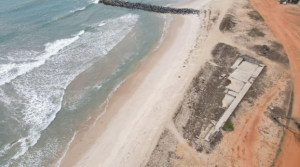[ad_1]
The frontal view of the 240-year-old Fort Prinzenstein in Keta in the Volta region shows an indestructible fortress. Its rear, however, uncovers decades of destruction caused by the intense tidal waves from the Atlantic Ocean. A remarkable rise in the sea level has left neighboring villages fully submerged under the water and threatening the two and half-centuries-old heritage monuments.
About two-thirds of the fort currently lies in the belly of the ocean, said James Ocloo Akorli, 45, the fort’s caretaker who grew up in Keta. Eight of the fort’s 10 dungeons—built initially to hold enslaved Africans as part of the transatlantic slave trade––had been entirely covered by the rising sea level by the time a sea defense wall was built to preserve the monument.
“Visitors to the fort are left disappointed when they get to see its poor state,” said Akorli, who doubles as the local government official for Keta Central Electoral Area where the fort is located. “It takes some amount of convincing to let them know it is safe to enter,” the caretaker said, pointing to the entrance which leads to a courtyard.
A little over 100 km east of Prinzenstein is Fort Kongenstein which was built in the 18th century in Ada, Greater Accra Region. It did not survive the raging tidal waves. Where the former slave post once stood is now the open Atlantic Ocean. There’s no visible trace of Kongenstein. A former prison yard and an abandoned graveyard for the early European settlers are the only remains of the once vibrant trading port.
Rising sea level accelerated by climate change is threatening not only the livelihoods of low-lying or below sea level communities but posing an existential threat to some of the country’s historic slave forts and castles found within these areas.
Human activities such as fumes or emissions from industrial production generate heat which is trapped in the earth’s atmosphere, over time leading to warmer temperatures. The rise in temperature leads to the melting of a large mass of ice, generating more water and making the sea level rise gradually. The steady shift in temperature and ultimately weather patterns is what is generally referred to as climate change.
The monuments, numbering about 21, were listed on the UNESCO World Heritage List in 1979 in recognition of their “enormous historical relevance” for local communities along the shoreline and the rest of the world.
In 2020, the UN agency found that some of the monuments, which constituted a significant and controversial symbol of European-African encounters and the origin of the African Diaspora and were to be preserved for posterity, were mostly falling apart.
In its report, the agency wrote that climate change-related threats such as coastal erosion, a phenomenon where strong tidal waves encroach on the coastline and unpredictable torrential rains have exacerbated structural integrity issues, have been caused by years of neglect and lack of maintenance.
“Because the forts and castles are situated along the coastal zone, the components are extremely vulnerable to environmental disturbances linked to climate change,” the report read.
Compared to the forts, Ghana’s three castles located in Accra, Cape Coast and Elmina remain in better condition. Sea walls built in Elmina and Cape Coast, both in the central region, helped provide a buffer not only for the towns but also for the two historical sites.
Nevertheless, the 360-year-old Christianborg Castle in Osu, Accra, which served as the seat of government until 2013 remains barely protected. While several reasons abound for the decision to move the presidency away from the former slave post, the heightened risk of coastal erosion cannot be discounted, said Prof. Kwasi Addo Appeaning, Director of the Institute of Environment and Sanitation Studies of the University of Ghana.
Sea walls
Ghana loses an average of two meters of its coastline annually to coastal erosion. In some areas, the rate of erosion measured rose by as much as 17 meters, a study published by the Institute of Environment and Sanitation Studies said.
In Keta, where Prinzenstein is located, rampant coastal flooding fueled by erosion measured between four and eight meters per annum and led to the construction of the 8.3km Keta Sea Defence Wall Project in the early 2000s.
The US$94 million project which was funded through a loan from the United States Export-Import Bank (Ex-Im Bank) saw the construction of a wall that kept the ocean at bay so that it could not cause further erosion to the coastline.
Despite sea walls’ growing popularity in battling coastal erosion, sea walls are costly and sometimes aggravate erosion or flooding in the adjoining unprotected beaches. In 2018, flash tidal waves submerged several villages in the Keta Municipality, forcing hundreds of residents to flee their homes and abandon their livelihoods.
“After the construction of the sea defense wall, some parts of Keta, especially the downstream side, started eroding at a very high rate,” said Prof. Appeaning. “Erosion in some areas measured as much as 17 meters in a year.”
Notwithstanding the lingering effects of sea defense walls, they helped keep the destructive tial wave at bay from Prinzenstein, preventing a total collapse. Two other former slave forts in the low-lying coastal twin towns of Old Ningo and Prampram in the Greater Accra region, which did not benefit from the protection of a sea defense wall, are on the brink of complete disintegration.
Of the two, what is left of the 289-year-old Fort Fredensborg in Old Ningo is merely a stump that used to house the fortress’s armory. Fort Vernon, which appears to have weathered an onslaught of tidal waves lashing unto its base, is on borrowed time.
“It [Fort Vernon] is now a death trap,” said Joyce Ayorkor Guddah, the Tourism and Culture Officer in Ningo Prampram District, the local government office.
While the Ghana Museums and Monuments Board, the government agency in charge of these forts, is aware of the imminent danger to Fort Vernon, Guddah added that little had been done to rescue the monument.
“Losing the fort will leave a big revenue loss in our bid to harness its tourism potential,” said Guddah. “And for the people, it will erase an important part of their history.”
Climate change’s scourge on heritage sites is not uncommon, especially in Africa, where countries have found conservation costly.
Governments are increasingly warming up to the idea of losing some of these heritage sites to the effects of climate change for good, said Will Megarry, who works at the International Council on Monuments and Sites (ICOMOS) as its Focal Point for Climate Change.
“They are accepting that the sites are going to be lost and what they’re trying to do in the interim is preserve them by the record,” said Megarry.
“They’re using things like drones, 3D scanning to preserve these sites, accepting that it’s not going to be possible to protect them.”
Local response
Ghana’s ability to stave off climate change impacts on its heritage sites is a costly endeavor the government has demonstrated it cannot shoulder without seeking external assistance with the Keta Sea Defence project and other similar projects proving this point.
In November 2022, the country’s President Nana Akufo-Addo speaking in Egypt at COP27, the UN’s climate change conference, reminded richer countries that generate more emissions into the environment of their promise to help vulnerable nations like Ghana mitigate the impact of climate change.
“Payment is overdue for the loss and damage suffered by our most vulnerable and least responsible nations,” President Akufo-Addo said.
These vulnerable nations, mostly small islands or countries with smaller economies, have demanded their counterparts support a fund that will help in dealing with the fallout of climate change. The conference raised more than US$230 million in pledges the fund—an amount which falls short of the US$100 billion per annum the vulnerable countries have persistently demanded.
While Ghana and other vulnerable countries wait on the well-endowed economies to make good their promises, the Ghana Museums and Monuments Board, the government agency that manages these heritage sites, remains cash-strapped, barely generating enough revenue to fund conservation plans.
“As a country, we have not done enough in conserving these monuments apart from the notable ones in Accra, Cape Coast, and Elmina,” said Bernard Agyiri Sackey, Director of Monuments at Ghana Museum and Monuments Board.
The government’s inability to fund conservation plans has led to monuments board the benevolence of institutions like UNESCO, the UN agency which had identified these former slaved posts as having “Outstanding Universal Value” that transcend national boundaries and are of importance for present and future generations of all humanity.
Forty-four years after recognizing the uniqueness of the former slave posts, the UN agency has committed almost US$280,000 to fund various conservation works in Ghana. It’s worth noting that the agency is not obliged to financially support the maintenance of these monuments, although countries seeking to carry out restorative works are mandated to notify the U.S. agency.
With Ghana looking to position its forts and castles at the center of its audacious tourism drive christened “Year of Return”—a campaign inviting descendants of enslaved Africans to reconnect with the land of their ancestors— the existential threat faced by these historical sites appears problematic.
With poorer countries that ironically contribute less to climate change inexplicably affected by its impacts, there are suggestions that prosperous countries must shoulder the bigger responsibility of supporting the affected countries to manage fallout like a threat to heritage sites.
“We are not a funding agency like some of our sister UN agencies that have funds,” said Carl Ampah, the National Programme Officer for Culture at UNESCO Ghana.”
“We are the intellectual arm of the UN. We come up with the ideas and strategies to resolve some of these issues.”
The agency is currently helping the Ghana Museums and Monuments Board draft a management and conservation plan for all the listed heritage sites in Ghana. The project will undertake a needs assessment of the monuments, paving the way for the government and other stakeholders to have a fair idea of what would be required to maintain the status of these sites.
“Losing these forts is not something I can imagine. It will be devastating whether in terms of the lost heritage or the potential for maximizing tourism opportunities,” said Sackey.
This story was produced with support from the Pulitzer Center.
The sea wall provides a buffer for Fort Prinzenstein in Keta, protecting what is left of the 240-year-old former slave post from further coastal erosion. Image by: Richard A. Abbey
Fort Kongenstein in Ada has been completely submerged by the Atlantic Ocean. The stump of nearby local primary school flattened by the destructive Atlantic Ocean.

Image by: Richard A. Abbey
Richard Annerquaye Abbey || abbeykwei@gmail.com
[ad_2]
Source link


